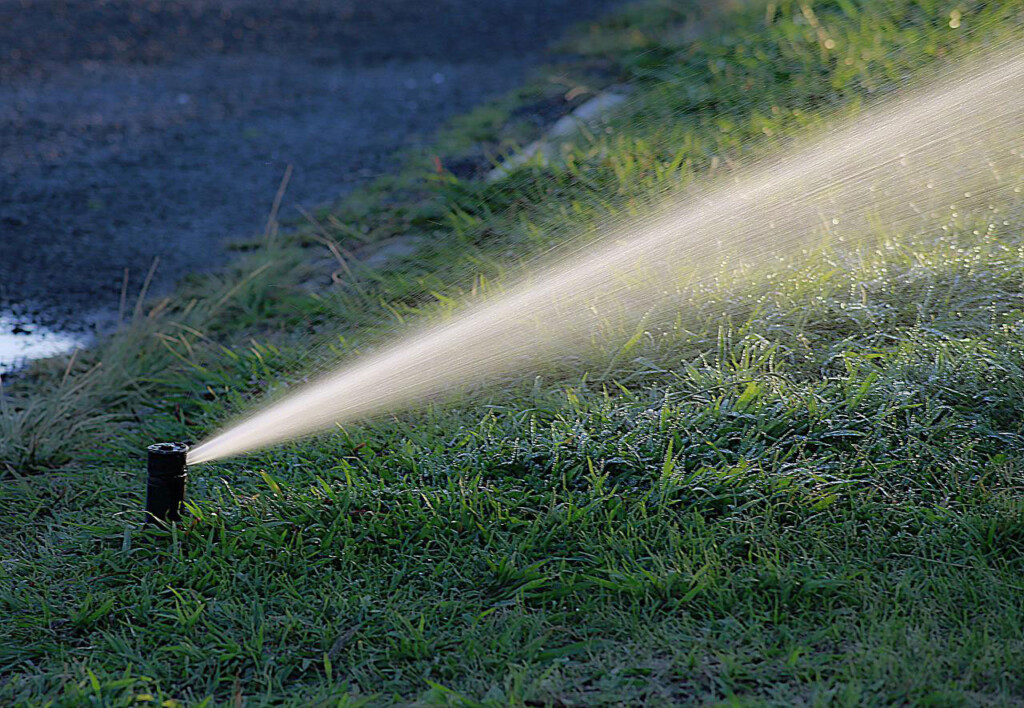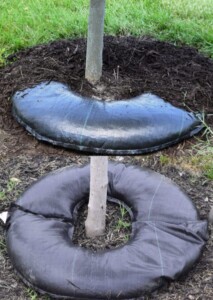
On this page you’ll find instructions for –
- Watering plants
- How to determine if watering is necessary
- Working with automated irrigation systems
- Watering sod
- Fertilizing
- Mulching
- Tree staking
- Pruning
- Insects
- Dead plants
Watering Plants
The critical period for watering newly installed plants is the 1st 6-8 weeks after installation. During this time plants are experiencing a transition to a new environment, and in some cases must overcome stress from being transplanted. If plants are allowed to dry out for more than a day or two many varieties may quickly defoliate or die.
During this period following planting water plants 2-3 times per week, except during cool weather or in periods of frequent rainfall when the soil remains moist. As a rule, plants require one inch of water per week, although additional water may be required if rainfall from thunderstorms does not soak into the ground.
After the initial 6-8 week period water every 3-4 days, or as needed depending upon weather conditions. In hot, dry weather regular deep watering is mandatory in the 1st year after installation. In cooler weather, one watering per week should be sufficient.
Note – Schip and Otto Luyken laurels, and flowering cherry trees are very susceptible to overwatering and damp soils. Soil in the area of laurels and cherries should be allowed to dry completely prior to watering.
How to determine if irrigation is necessary?

The most efficient watering method is to apply water so that runoff is minimized. For individual tree plantings, a hose should be placed near the trunk with a trickle of water for ½ hour each. Planting bed areas are best watered with a soaker hose. A sprinkler may be used but should remain in one area until the ground is thoroughly saturated at least a couple of hours. Soaker hoses lose less water to evaporation and apply the water most directly to the areas where moisture is needed.
Irrigation devices such as the GatorBag or Tree Diaper (below) slowly disperse water to trees. These are particularly useful for trees planted a distance from a water faucet. The Tree Diaper absorbs water from rainfall, so it does not need to be refilled.

Automated Irrigation Systems
Irrigation systems are typically programmed for watering shallow-rooted lawns, and not for deeper-rooted plants. Moisture meters are particularly helpful for measuring soil moisture to determine if longer or shorter periods of irrigation are needed for shrubs and trees.
Watering Sod
Newly installed sod should be watered every other day until the sod roots, usually several weeks. Watering should be done with a sprinkler to ensure even coverage. It is important to water deeply so that roots are encouraged to go down into the soil, normally a couple of hours with a sprinkler.
Failure to water newly installed sod in warm weather will quickly kill sod since its’ root system is so shallow. After the sod roots watering can be curtailed so that it dries out slightly. During the heat of Summer sod will have to be watched very carefully, but normally watering twice a week will keep it sufficiently moist.
Fertilizer
Additional fertilizer is not required in the first year after planting. Soil amendments incorporated during planting should have enough nutrients for growth during the first year. We sometimes use a plant hormone/ biostimulant with trace amounts of fertilizer called ROOTS. There are other similar products that can help ease the adjustment of a plant through the transplant stage after initial installation.
Plants can be fertilized in the first Spring after installation. A fertilizer such as Mir-Acid or MiracleGro, applied to foliage is very beneficial but can be quite laborious. Dry and granular fertilizers, in particular organic fertilizers such as HollyTone, are best suited to ease of application. HollyTone works well with the acid-loving plants that we typically plant, and has a high margin for error in protecting against over-application. Always follow product directions, but err on the side of too little fertilizer rather than too much. Do not apply fertilizer to plants from late August through November, or it may encourage new growth that can be injured by freezing temperatures.
Mulch
Shredded hardwood mulch should be maintained at a 2-3 inch thickness on plant beds until plants have covered the area. This will discourage weed growth and conserve soil moisture. Mulch will normally need to be replenished once every year. The choice of mulch type is a personal decision. We use shredded hardwood as a standard because it is most widely accepted in our area. Pine bark chunks, cedar bark, pine needles, and a variety of other materials can also be used to mulch.
Exercise caution when adding mulch not to mulch close to the trunk of trees, and not to mound mulch up against the trunk of any plants. Also, plants such as rhododendrons and azaleas do not like to have any more than one inch of mulch over their roots.
Tree Staking
Stakes should remain on trees until they are self-supporting, usually up to one year from installation. Be sure to remove wires from trunks or branches so they do not girdle the tree. Small trees may not require stakes, or the period they are required may be shorter. Large evergreens with greater wind resistance are the most critical to leave staked for a full year.
Pruning
Occasionally, a plant will require pruning to maintain its’ shape or size. Pruning trees is best performed by a professional, but most shrubs can be pruned without any ill effects. Although pruning can be done with power or manual hedge shears, the best results will be achieved by pruning with hand pruners to give a more natural appearance. Pruning deciduous trees is best performed after leaves drop in the Fall. Evergreens and most shrubs are not particular about the time of year they are pruned. However, some flowering plants must be pruned prior to developing flower buds, or the bloom for the next year will be diminished.
Insects
Most insect problems with newly installed plants will involve leaf-eating pests such as Japanese Beetles or caterpillars. Spider mites and bagworms can be a problem for plants with needles, and lace bugs in azaleas and Pieris. Insect infestations are seldom so severe that they kill an otherwise healthy plant, and many people choose to ignore them in all but the most severe cases. There are a number of natural, organic, and chemical remedies for each pest. Garden centers and local extension agents can be helpful in identifying insects and directing them toward the proper treatment.
Dead Plants
A near certainty in installing plants is that some will fail to survive or thrive. There are so many challenges, from inclement weather to poor soil conditions, and plants are more vulnerable to problems in their first year. The most common reason for the failure of a newly installed plant is lack of water. Without it, most plants don’t have a chance. The second most common reason for plants dying is too much water, caused by the poor drainage of clay soil in our area. The extreme temperatures of Winter and Summer also contribute their share of plant losses.
When plants that we have installed die or appear to be dying call the Landscape Department and our Customer Service Department will take the information needed to determine which plants require replacement. We will normally assign one of our Customer Service representatives to visit within 10 working days to verify the health of the plants in question and to attempt to gain some insight into why the plant is not performing as we expect. If we see a problem we may suggest making a change in plant variety, adding soil to raise a plant from poorly drained soil, changing a plant’s location, or some other remedy.

